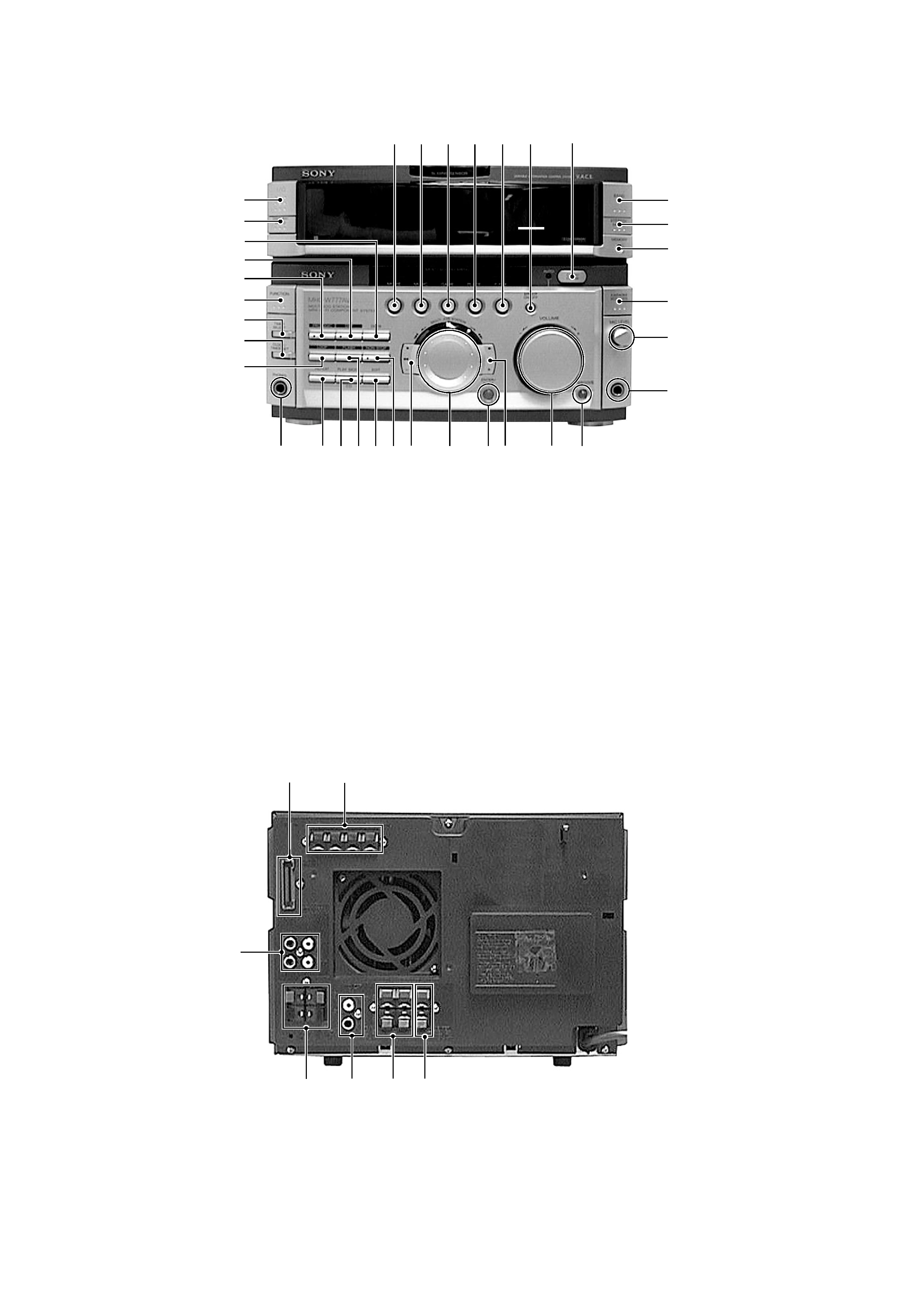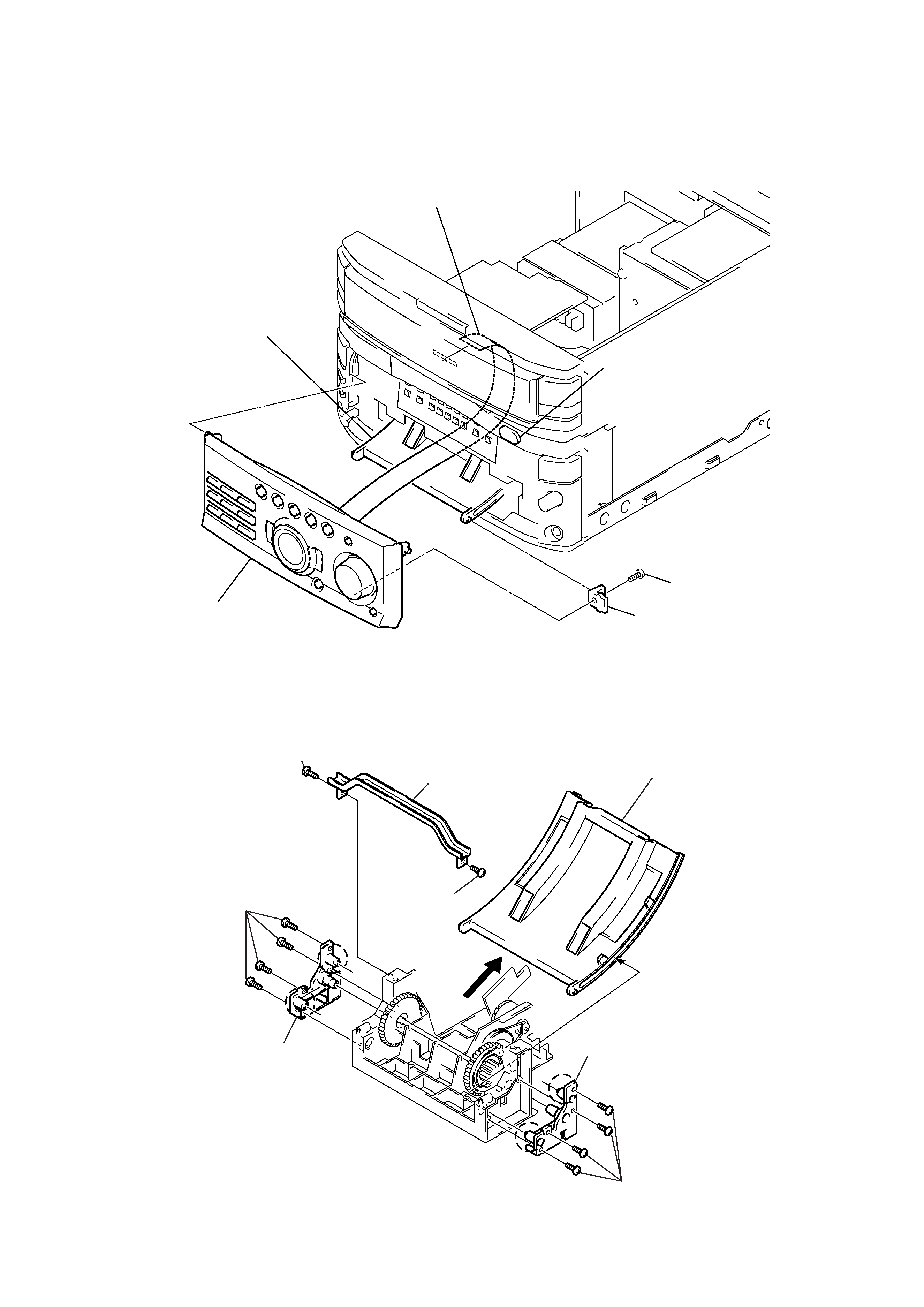
STR-W777
AEP Model
UK Model
E Model
Australian Model
SERVICE MANUAL
FM STEREO/FM-AM RECEIVER
MICROFILM
SPECIFICATIONS
STR-W777 is the tuner and amplifier
section in MHC-W777AV.
Amplifier section
(Saudi Arabia, Singapore, Malaysia,Thai, Australian)
The following measured at AC 230V 50/60 Hz
DIN power output (Rated) (FRONT)
95 + 95W (6
at 1kHz DIN)
Continuous RMS power output (Reference)
FRONT SPEAKER: 110 + 110W
(6
at 1kHz, 10% THD)
CENTER SPEAKER: 55W
(8
at 1kHz, 10% THD)
REAR SPEAKER: 35 + 35W
(8
at 1kHz, 10% THD)
The following measured at AC 120, 220, 240V 50/60Hz
DIN power output (Rated) (FRONT)
100 + 100W (6
at 1kHz DIN)
Continuous RMS power output (Reference)
FRONT SPEAKER: 120 + 120 W
(6
at 1kHz, 10% THD)
CENTER SPEAKER: 60W
(8
at 1kHz, 10% THD)
REAR SPEAKER: 40 + 40W
(8
at 1kHz 10% THD)
Peak music power output 2400W
(AEP, UK, East European, CIS)
DIN power output (Rated) (FRONT)
80 + 80W (6
at 1kHz DIN)
Continuous RMS power output (Reference)
FRONT SPEAKER: 100 + 100W
(6
at 1kHz, 10% THD)
CENTER SPEAKER: 60W
(8
at 1kHz, 10% THD)
REAR SPEAKER: 35 + 35W
(8
at 1kHz, 10% THD)
Music power output (Reference)
FRONT SPEAKER: 190 + 190 W
(6
at 1kHz, 10% THD)
CENTER SPEAKER: 90W
(8
at 1kHz, 10% THD)
REAR SPEAKER: 55 + 55W
(8
at 1kHz, 10% THD)
Inputs
MD/VIDEO 1 IN (phone jacks): voltage
450/250mV, impedance 47k
AV INPUT AUDIO (phone jacks): voltage
250mV, impedance 47k
MIX MIC (phone jack): sensitivity 1mV,
impedance 10k
-- Continued on next page --

-- 2 --
Output
MD/VIDEO 1 OUT (phono jacks): voltage
450/250mV, impedance 1k
PHONES (stereo phone jack): accepts
headphones of 8
or more.
FRONT SPEAKER:
accepts impedance of 6 to 16
CENTER SPEAKER:
accepts impedance of 8 to 16
REAR SPEAKER:
accepts impedance of 8 to 16
SUPER WOOFER:
Voltage 1V, impedance 1k
Video section
Inputs
AV INPUT VIDEO (phone jack): 1Vp-p, 75
Outputs
MONITOR OUT (phone jack): 1Vp-p, 75
Tuner section
FM stereo, FM/AM superheterodyne tuner
FM tuner section
Tuning range
3 band type model
87.5 108.0MHz (50kHz step)
4 band type model
65.0 74.0MHz (10kHz step)
87.5 108.0MHz (50kHz step)
Aerial
FM lead aerial
Aerial terminals
75
unbalanced
Intermediate frequency
10.7MHz
UKV tuner section (4 band type model only)
Tuning range
65.0 74.0MHz (10kHz step)
Polar Stereo
AM tuner section
Tuning range
Australian model:
531 1,602kHz (with the AM tuning interval
set at 9kHz)
530 1,710kHz (with the AM tuning interval
set at 10kHz)
Other models:
MW: 531 1,602kHz (with the MW tuning
interval set at 9kHz)
530 1,710kHz (with the MW tuning interval
set at 10kHz)
SW: 5.95 17.90MHz (with the SW tuning
interval set at 5kHz)
LW: 153 279kHz (with the interval set at
3kHz)
Intermediate frequency
450kHz
Antenna
AM loop antenna External antenna terminal
General
Power requirements
Australian models:
240V AC, 50/60Hz
AEP, UK, East European, CIS models:
230V AC, 50/60Hz
Other models:
120V or 220V or 230 240, 50/60Hz
Adjustable with voltage selector
Power consumption
270W (AEP, UK, East European, CIS models)
300W (Other models)
Dimensions (w/h/d)
Approx. 288
× 205 × 375mm
Mass
Approx. 8.8kg
Supplied accessories:
AM loop antenna (1)
Remote RM-SR77 (1)
Size AA (R6) batteries (2)
FM lead antenna (1)
Speaker cords (5)
Front speaker pads (8)
Design and specifications are subject to change without notice.

-- 3 --
TABLE OF CONTENTS
1. GENERAL ........................................................................... 4
2. DISASSEMBLY
· Sliding Panel Assembly ...................................................... 5
3. SERVICE MODE .............................................................. 6
4. ELECTRICAL ADJUSTMENT ................................... 11
5. DIAGRAMS
5-1.
Circuit Boards Location ··················································· 12
5-2.
Block Diagrams
· Tuner Section (AEP, UK model) ···································· 13
· Tuner Section (East European, CIS model) ··················· 15
· Main Section ·································································· 17
· Power Section ································································ 19
5-3.
Schematic Diagram
Tuner (AEP, UK model) Section ································· 23
5-4.
Printed Wiring Board
Tuner (AEP, UK model) Section ································· 25
5-5.
Printed Wiring Board
Tuner (East European, CIS model) Section ················ 26
5-6.
Schematic Diagram
Tuner (East European, CIS model) Section ················ 27
5-7.
Printed Wiring Board Main Section ··························· 29
5-8.
Schematic Diagram Main (1/2) Section ····················· 31
5-9.
Schematic Diagram Main (2/2) Section ····················· 33
5-10. Schematic Diagram AV/Mic Section ·························· 35
5-11. Printed Wiring Board AV/Mic Section ······················· 36
5-12. Schematic Diagram Power Amp Section ··················· 37
5-13. Printed Wiring Board Power Amp Section ················· 39
5-14. Schematic Diagram Display Section ·························· 41
5-15. Printed Wiring Board Display Section ······················· 43
5-16. Schematic Diagram Sliding Panel Section ················· 45
5-17. Printed Wiring Board Sliding Panel Section ·············· 47
5-18. Schematic Diagram Surround Section ······················· 49
5-19. Printed Wiring Board Surround Section ····················· 51
5-20. Printed Wiring Board Trans Section ··························· 53
5-21. Schematic Diagram Trans Section ····························· 55
5-22. IC Block Diagrams ··························································· 56
5-23. IC Pin Function ································································ 60
6. EXPLODED VIEWS
6-1.
Case and Sliding Panel Section ........................................ 63
6-2.
Front Panel Section .......................................................... 64
6-3.
Slide Mechanism Section ................................................. 65
6-4.
Circuit Boards and Back Panel Section ............................ 66
7. ELECTRICAL PARTS LIST ........................................ 67
SAFETY-RELATED COMPONENT WARNING !!
COMPONENTS IDENTIFIED BY MARK !OR DOTTED LINE
WITH MARK ! ON THE SCHEMATIC DIAGRAMS AND IN
THE PARTS LIST ARE CRITICAL TO SAFE OPERATION.
REPLACE THESE COMPONENTS WITH SONY PARTS
WHOSE PART NUMBERS APPEAR AS SHOWN IN THIS
MANUAL OR IN SUPPLEMENTS PUBLISHED BY SONY.
LABEL MODEL NUMBER
No.
MODEL IDENTIFICATION
-- BACK PANEL --
Saudi Arabia, Singapore, Malaysia
4-900-848-2
Thai, Australian
4-900-848-3
AEP, UK, East European, CIS
4-900-848-4
MODEL
PART No.

-- 4 --
Front Panel
SECTION 1
GENERAL
1 2 3 4 5 6
7
8
9
!º
!¡
!TM
!£
!¢
!
!¶!§
@
@§
@¶
@·
@ª
#£
#¢
#º
!·
!ª
@¡
@£
@¢
@º
#¡
#TM
@TM
Rear Panel
2
4
5
3
1
6
7
1 MOVIE button
2 MUSIC button
3 GAME button
4 PLACE button
5 P FILE button
6 EFFECT ON/OFF button
7 OPEN/CLOSE button
8 TUNER BAND button
9 STEREO/MONO button
!º MEMORY button
!¡ KARAOKE PON/MIX button
!TM MIC LEVEL dial
!£ MIX MIC jack
!¢ GROOVE button
! VOLUME dial
!§ ) + button
!¶ ENTER/NEXT button
!· MULTI JOG STATION dial
!ª 0 button
@º NON-STOP button
@¡ EDIT button
@TM FLASH button
@£ PLAY MODE button
@¢ REPEAT button
@ PHONES jack
@§ LOOP button
@¶ CLOCK/TIMER SET button
@· TIMER SELECT button
@ª FUNCTION button
#º PROLOGIC button
#¡ DSP button
#TM DBFB button
#£ DISPLAY/DEMO button
#¢ I/u (POWER) button
1 SYSTEM CONTROL jack
2 ANTENNA terminal
3 CENTER SPEAKER terminal
4 REAR SPEAKER terminal
5 MONITOR OUT jack
6 FRONT SPEAKER terminal
7 MD/VIDEO 1 jack

-- 5 --
SECTION 2
DISASSEMBLY
Note: Follow the disassembly procedure in the numerical order given.
2-1. SLIDING PANEL ASSEMBLY
4 Flat type cable (19 core)
2 Screw (BVTP 3x8)
3 Holder level
5 Sliding panel assembly
Slide mechanism
1 Push the OPEN/CLOSE button to
open the Sliding panel assembly.
1 Screw (BVTP2.6x8)
4 Four screw
(BVTP2.6x8)
5 Holder (L) assembly
a
a
b
b
6 Four screw (BVTP2.6x8)
7 Holder (R) assembly
8 Remove the Level slider direction of arrow.
2 Screw
(BVTP2.6x8)
3 Top bracket
· NOTE FOR INSTALLATION (LEVEL SLIDER)
NOTE :
Attach in the reverse order, but make sure the rollers (
a, b) of the
holder (L) assembly and holder (R) assembly fit into the grooves of
the level slider.
